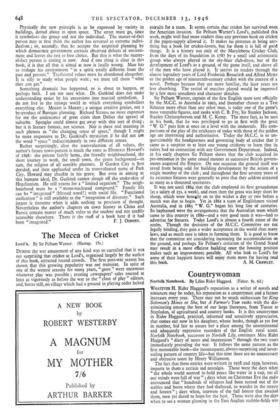A Pattern for Towns
Revolution of Environment. By E A. Gutkind. (Kegan Paul. 30s.) As this book is published under distinguished academic auspices, the reader assumes that it is recommended as a careful contribution to thought. Some justification may be found in the fact that it reflects curiosity in the important and under-explored field of urban sociology and assembles a quantity of interesting historical material. But the material is not digested ; the book is not articulated, and the opening chapters, which are mainly prescriptive, are so full of dubious generalisations that the reader becomes distrustful of the later historical chapters—possibly unjustly.
The author is, in principle rightly, scornful of " matter-of-fact " persons who do not respect a philosophical approach to planning. But a pontifical manner i.. not a certificate of intellectual authority, and it is on the philosophical flank that the author himself is most open to criticism. A symptom of this appears at the very beginning of the book. The "revolution of environment" is, in the first paragraph, stated to be " the problem" ; in the second paragraph it is an event that has occurred and is to be studied ; in paraaraph nine it is something that may be brought about in the future. 4'This would be confusing enough if it were mere carelessness of language. Unfortunately the confusion goes deeper. Despite a prolonged study, I cannot make out what the author's political philosophy is. Indeed, he seems to me to be in a state of transition from some sort of Hegelian belief in society as an organism, to be planned by an undefined elite on a system of values that are social or collective, towards a belief fundamentally different, in which the primary values are those of personality, but in pursuance of which it is still an elite that does the planning. With an echo of Nietzsche's adolescent glee at his own " evil " thoughts, he presents as a daring revolutionary precept the right of each man to choose his own style of living, in seclusion or society. But the dynamic still seems to come from above, though the process is missing.
Physically the new principle is to be expressed by variety in buildings, dotted about in open space. The street must go, since it symbolises the group and not the individual. The matter-of-fact person may at first think the author has reverted to extreme indivi- dualism ; or, secondly, that he accepts the empirical planning by which democratic government corrects observed defects of environ- ment and leaves the rest to free choice. But that is what the matter- of-fact person is aiming at now. And if one thing is clear in this book, it is that all that is aimed at now is fatally wrong. Man has to reshape his environment " in a spirit totally different from the past and present." Traditional values must be abandoned altogether. It is silly to study what people want ; we must tell them " what they can get."
Something dramatic has happened, or is about to happen, or perhaps both. I am not sure what. Dr. Gutkind does not make understanding easier by his excursions into musical symbolism. I do not live in the strange world in which everything symbolises everything else. Mozart is Mozart ; a unique creative genius, not a by-product of Baroque planning. Richard Strauss no more expresses for me the coalescence of great cities than Delius the sprawl of suburbs. Spengler could almost get away with this sort of thing ; but it is literary fantasy, not science. Nor is there real meaning in such phrases as " the changing sense of space," though I might be more responsive to Dr. Gutkind's mysticism if he did not use the word " space " indiscriminately in two different senses.
Rather surprisingly, after the transvaluation of all values, the author's future town-pattern is much the same as Ebenezer Howard's of 1898: the private family home, the friendly neighbourhood, the short journey to work, the small town, the green background—in sum, the religion of all sensible planners. If Garden City is first derided, and then applauded under its transvaluated name of Park City, Howard may chuckle in his grave. But even in aiming at this humane ideal, Dr. Gutkind cannot slough off the snake-skin of Regelianism. He still yearns for a " limited organism." The neigh- bourhood must be a " mono-nucleated compound." Family life can be " integrated " (blessed word!) with social life. " Functional unification " is still available as the " integration of diversity." Such jargon is tiresome when it adds nothing to precision of thought. Nevertheless the author's chapters on town history in China and Russia contain matter of much value to the student and not readily accessible elsewhere. There is the stuff of a book here if it had



































 Previous page
Previous page